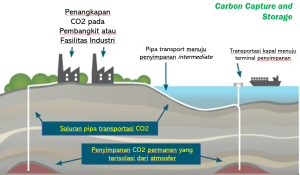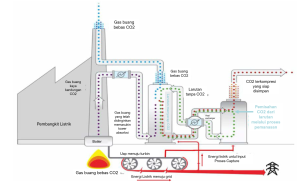Author : Aditya Perdana Putra Purnomo (Research team intern 2022)
Editor: Pamela Simamora
The use of fossil fuels since the beginning of the industrial revolution has been shown to increase anthropogenic[efn_note] Carbon dioxide produced by human activities.[/efn_note] carbon dioxide emissions that are responsible for an upsurge in the earth’s surface temperature by 1.07 °C from 1850 to 1990.The increase in temperature harms the environment, causing events such as droughts, forest fires, flooding, and erosion of some coastlines.
Besides using renewable energy, Carbon Capture and Storage (CCS) is considered capable of helping in reducing world carbon emissions. CCS is a technology used to capture carbon dioxide from exhaust gasses, then transport and store the carbon dioxide gas in particular storage locations (usually underground) to avoid its negative impact released into the atmosphere.[efn_note] There is also another term for CCS technology, such as, CCUS (Carbon Capture, Utilization and Storage.The difference is that the extracted carbon dioxide is reused in industrial processes, thereby reducing the overall carbon footprint.[/efn_note] .
 Figure 1. CCS Schematic Diagram (Choudary,2016)
Figure 1. CCS Schematic Diagram (Choudary,2016)
By 2021, there are 31 CCS projects in commercial operation worldwide, and more than 90 other projects are still under development. This figure continues to increase and is the highest for the last 5 (five) years. Beside being caused by ongoing research, the increase in the number of projects is also inseparable from the support from various countries for CCS technology as an option to reduce carbon emissions.
Indonesia, as one of the largest carbon dioxide emitting countries in the world, has also begun to plan the use of CCS, especially in the electricity sector. This strategy is questionable given that CCS prices are and will remain uncompetitive against renewable energy plus storage. If CCS is installed, supercritical CFPP LCOE will double from EUR 40 per MWh to EUR 80 per MWh (USD 92 per MWh) even if transport and storage costs of CO2 remain low at around EUR 10 per tonne. In this case, the avoided CO2-eq cost is more than EUR 55 per tonne (USD 64 per tonne).

Figure 2. CCS Schematic Diagram of a Coal-fired Power Plant (Global CCS Institute, 2021[efn_note] Image translated. [/efn_note] )
One of the CCS projects in the electricity sector, the Petra Nova project in the United States, is predicted to be the trigger for the development of CCS in the electricity sector around the world. Unfortunately, the CCS at this 240 MW power plant experienced a 30% blackout before it was finally discontinued in 2020. Since its inauguration in 2017, from the target of capturing 4.2 million metric tons of carbon dioxide for 3 years of operation, the Petra Nova project has only succeeded capture 3.54 million metric tons of CO2, or 16% of the target.
Analysis from the Institute for Energy Economics and Financial Analysis (IEEFA) shows the poor performance has cost investors more than $23 million over the project’s three-year operation. In addition, during its lifetime, the Petra Nova project also generated more than 1.1 million metric tons of CO2 through the use of gas turbines for CCS power purposes. Learning from this case, Indonesia needs to reconsider the use of CCS in coal-fired power plants.
Another project, the Boundary Dam coal-fired power plant in Canada, also uses CCS to capture GHG generated from the electricity production of this 160 MW power plant. Equal to the Petra Nova project, the Boundary Dam project has also never operated according to its target of capturing 3200 metric tons of carbon dioxide annually. Judging from the achievement of annual carbon capture, the project is only able to capture carbon emissions of around 40 to 60% of the target. Even in the most productive year, the achievement was still far below the target of 3200 metric tons per year. This record was exacerbated by last year’s sluggish performance caused by a 3-month blackout of the CCS unit. The first outages took place from mid-June to July due to routine maintenance. However, shortly thereafter, a compressor failure[efn_note] Prior to storage and transportation, carbon dioxide must pass through a compression phase through a compressor engine.[/efn_note] brought the project to a complete shutdown from August to September 2021.

Figure 3. Achievement of Carbon Capture, Boundary Dam Project 2014-2021 (Schissel, 2021)
In other sectors, such as industry, CCS is considered one of the most effective solutions to reduce GHG emissions. The use of CCS in the industrial sector started in 1971 when the world’s first commercial CCS was operated at Terrell Gas Processing[efn_note] Terell gas processing in some literature is called del Verde, which is the former name of this project.[/efn_note] in Texas, United States of America. CCS, which is valued at 7.6 million[efn_note] The investment value was added again in 2007 by USD 10 million for pipeline expansion.[/efn_note] is still operating today. The project with a capacity of 0.4 MTPA[efn_note] MTPA stands for “Metric Tons per Annum” which means the total catch capacity of CCS per year.[/efn_note] is operated to capture CO2 emissions from the local gas processing industry and use this catch to increase oil well production through the Enhanced Oil Recovery (EOR)[efn_note]EOR is one method of increasing oil and gas production, through injection of CO2 into production wells.[/efn_note] . Another CCS project in the United States is at a fertilizer plant called Enid Fertilizer, that has been operating for 40 years. This project utilizes CO2 from the manufacture of fertilizer/ammonia to sell to oil and gas production wells in Oklahoma that carry out the EOR process.
From the case study above, several things need to be considered by policy makers in Indonesia to apply CCS in Indonesia. First, the use of CCS in steam power plants, apart from being expensive, also often experiences technical problems, resulting in not achieving the CO2 capture target promised by the developer. Second, the revenue from the sale of CO2 for EOR is the prime driver of CCS projects in the industrial sector in America. Although there is no publicly available data, CO2 prices for EOR are closely related to oil prices. For instance, with an oil price of US$70 per barrel, the CO2 price for EOR is around US$30/tCO2 (Bliss, et al., 2010). Therefore, the implementation of CCS in the industrial sector (and other sectors) requires a high carbon value which can ensure that the carbon values covers the costs of capturing and transporting CO2.***
Footnote:

